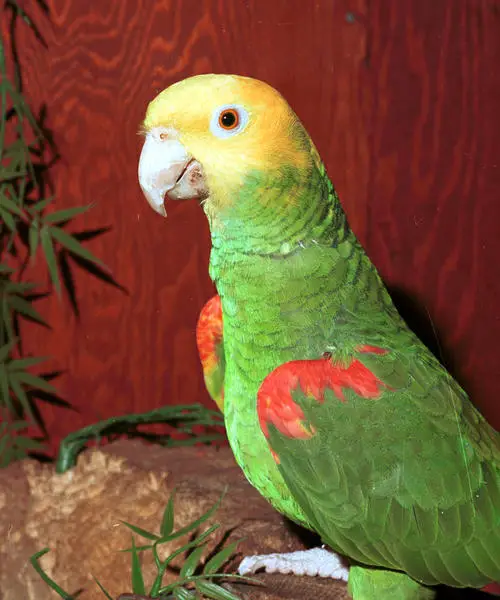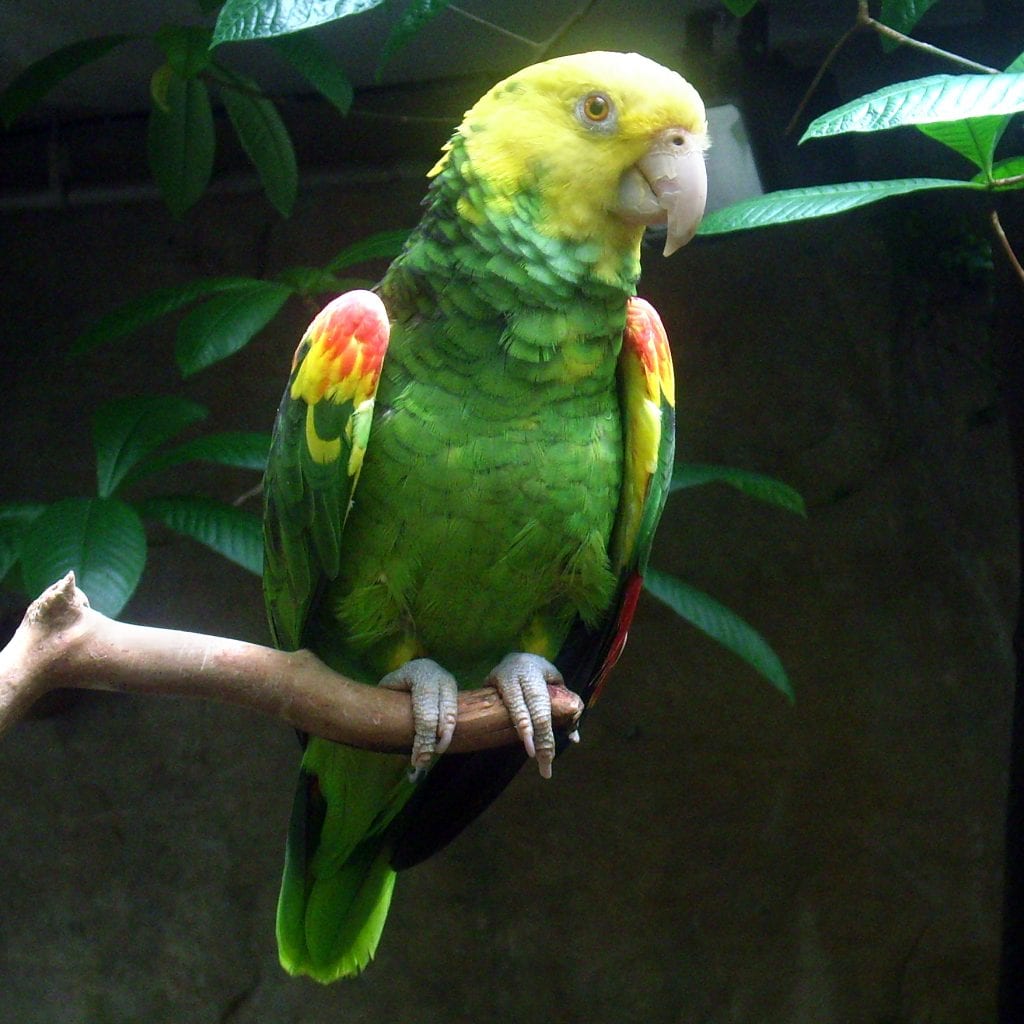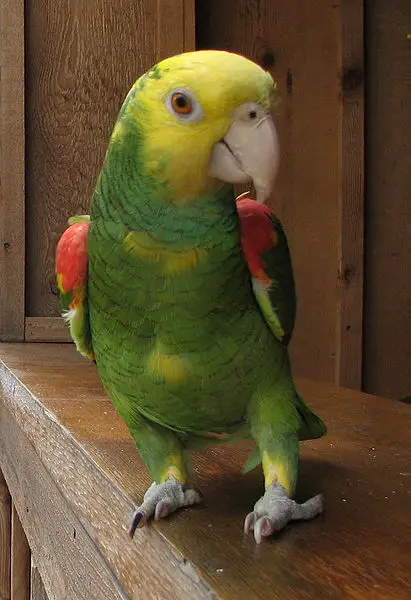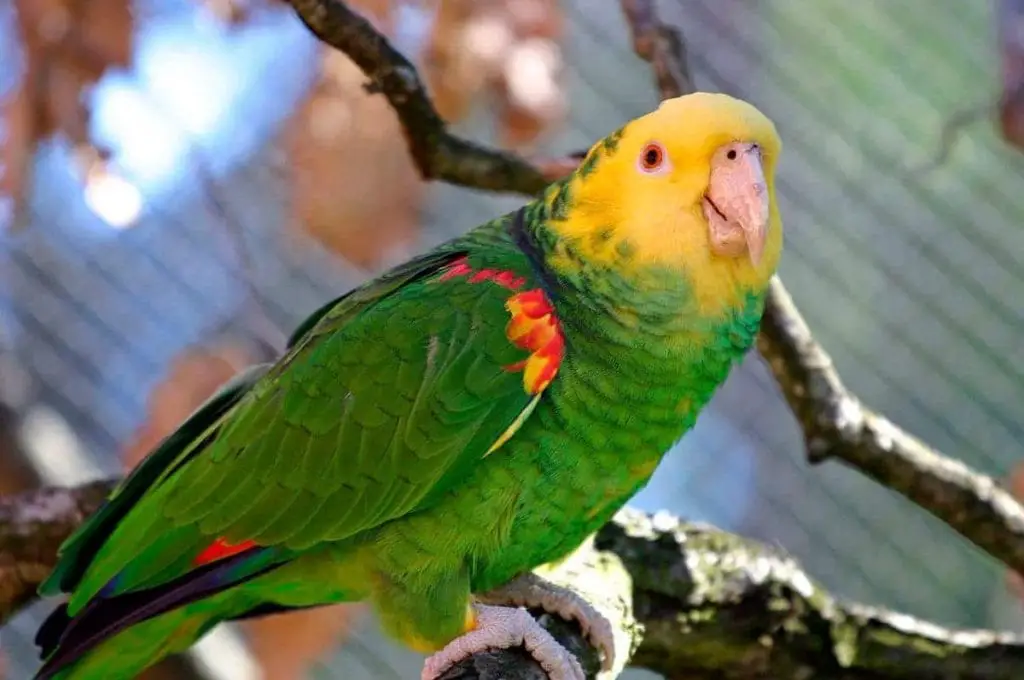Scientific Facts
| Common Name | Yellow-headed Amazon |
| Scientific Name | Amazona oratrix |
| Lifespan | 50 – 60 Years |
| Size | 14 – 15 inches (36 – 38cm) |
| Body Mass | 17.5oz. (500grams) |
| Habitat | Mangrove forests, forests near water bodies |
| Range | Northern Central America, Mexico |
Information & Physical Appearance

The yellow-headed amazon (Amazona oratrix) is a member of the order
Psittaciformes, the family Psittacidae, genus Amazona.Other common names include Yellow-headed Parrot, Levaillant’s Amazon, Mexican Yellow-headed Amazon, Mexican Yellow-fronted Amazon, Double Yellow-headed Amazon, and Double Yellow-fronted Amazon.
There are four races, with the nominate race included, namely
A.o. oratrix
A.o. tresmariae
A.o. hondurensis
A.o. belizensis
1. A.o. oratrix – Yellow Double-headed/ Yellow Double-fronted Amazon
In both adults, the body is bright green in general.
The feathers covering the neck, the back, as well as the area from the abdomen to the breast are only lightly dusted in black.
The head and the neck zone display yellow coloring. Although occasionally, there may be scattered green feathers visible in the neck area.
On the bend of the wing, vivid orange/red coloration can be noticed. On the lesser wing coverts, the red/orange coloration gets mixed with yellow.
The thighs are yellow, too, and so is the carpal edge, which may also sometimes be mixed with red/orange.
The wings are rounded. The green tail is square, with red at the very base. The outer tail feathers are tipped with yellowish.
The bill exhibits horn/yellow coloring.
There is a clearly defined white eye ring, with beautifully contrasting orange eyes.
2. A.o. tresmariae – Tres Marias Amazon
Both female and male tresmariae adults resemble oratrix adults.
However, Tres Marias Amazons display paler yellow coloring on the head, and the coloring reaches all the way to the foreneck and upper breast zones.
Also, there is a blue wash on the underparts.
3. A.o. belizensis –Belize Yellow-headed Amazon
In both sexes, the yellow coloring of the head is restricted to the lores, crown, forehead, around the eyes, around the ear coverts, and upper cheeks.
The yellow-naped color morph is characterized by a yellow patch that extends from the hindneck to the nape, and hence the common name “yellow-naped amazon.”
Additionally, yellow coloration is absent on the carpal edge, and the eye ring is in grey/white tones instead of strictly white, as seen in the nominate race.
4.A.o. hondurensis
Both hondurensis adults have varying plumage.
Hondurensis adults differ from belizensis adults by possessing yellow coloring only on the crown and on the forehead. A yellow patch extending from the hindneck to the nape may or may not be present.
On the bend of the wing, red color is mixed with yellow. Another difference is that the carpal edge is green.
Lifespan

Just like other Amazona species, Yellow-headed Amazons are well-reputed for their longevity. Yellow-headed Amazons can easily live up to 50 – 60 years of age in captivity, as long as they are provided with proper care.
The generation length is estimated at 12.3 years.
Ecosystem & Habitat

RANGE
Native to northern Central America and Mexico, yellow-headed amazon parrots are not migratory birds.
A.o. oratrix is found in the Caribbean slope, as well as in the Pacific slope of central Mexico.
A.o. tresmariae occurs off the coast of western Mexico,Isla Tres Marías
A.o. belizensis is native to Central El Peten and Belize and to northern Guatemala. Although isolated, there are populations found in northwestern Honduras and northeastern Guatemala, too.
A.o. hondurensis inhabits a limited range in northwestern Honduras, Valle de Sula.
HABITAT
Yellow-headed parrots are known as highly adaptable, and they can thrive in a variety of habitats, including savanna woodland, dense gallery woodland, riparian forests, deciduous forests, and forest clearings.
In Belize, yellow-crowned amazons are found in Pinus ridges and woodlands, while in Guatemala, they are found in coastal swamp forests, mangroves, and nonetheless, in cultivated areas characterized by the availability of scattered trees.
Food & Diet

Yellow-headed amazons’s wild diet consists of young leaves, buds, flowers, and palm fruits.
More specifically, these parrots are reported to consume selected parts of Pithecellobium dulce (monkeypod), Astronium graveolens’ seeds (glassy wood), Crataeva tapia (garlic-pear tree), mango flowers, Ficus fruits, and Sideroxylon capiri(tempisque tree)
Behavior

Like other Amazona species, yellow-headed amazons are known for their natural social behavior.
They are typically found in pairs (during the breeding season) or flocks (outside the breeding season).
Also, larger gatherings take place at feed areas, and at communal roosts.
Reproduction

Yellow-headed amazons’s breeding season starts in early March and continues throughout April.
These birds produce a single clutch. The clutch size varies from 2 to 4 eggs. Most commonly, there are 3 eggs per clutch.
The eggs are ovate and measure 1.4 x 1.2 inches.
The female incubates the eggs for a period of about 26 days. The young chicks weigh as little as 0.5oz. upon hatching, and are to fledge in 9 weeks.
Survival Threats & Conservation

Yellow-headed amazons are listed on CITES’ Appendix I.This international treaty makes the trade, export, and import of wild-caught yellow heads strictly illegal.
Nonetheless, trade-in yellow-headed amazons bred in aviculture is subjected to controls, too.
Any captive-bred yellow-headed amazons can be only sold and owned legally after being subjected to specific checks and regulations.
Ultimately, captive-bred individuals have to possess an official certification, which should be provided by the breeder. These individuals will also have a closed ring on one of their legs.
Furthermore, the Amazona oratrix is classified under the endangered category on the IUCN Red List of Threatened Species.
The major survival threats include
- Heavy trapping for wild bird trade (tragically, between 40% – 60% of poached yellow heads have been estimated to die prior to being sold. According to statistics, there are almost 50 000 parrots that get smuggled in inhumane conditions).
- Extensive habitat loss (majorly due to the clearing of land for pasture and agriculture, which is the case with 80% of the Tamaulipas lowlands). Also driven by residential and commercial development related to modern-day housing and urban areas.
- Hunting and persecution
Sadly, poaching efforts keep being fueled by the yellow-headed amazons’s high popularity as pets.
The wild population is currently estimated at about 4700 sexually mature individuals, declining rapidly from 70 000 sexually mature individuals in the wild back in the past two decades.
The population trend is decreasing, based on the results of the 2018 global assessment.
While conservation sites are identified over the entire range and the species is found to occur in at least one protected area, there is no systematic monitoring scheme.
Conservation efforts include the establishment of an active recovery plan.
Availability – Where to Get a Yellow-headed Amazon
Yellow-headed amazons’s captive status across the US is regarded as fairly common. Throughout the rest of the world, yellow-headed parrots are considered somewhat common as pets.
Double-headed amazons are more widely available than Tresmariae amazons (Amazona Ochrocephala Tresmariae) and Magna amazons (Amazona Ochrocephala Magna).
Being commonly bred in captivity, double yellow-headed amazons are usually quite easy to find in a variety of avian-specialty stores. Also, they are available for sale directly from bird breeders.
One can also find a yellow-headed amazon available from adoption (rescue) organizations.
Note that baby yellow-headed amazons are typically available at the beginning of the autumn season. However, what generally determines availability is the part of the country these parrots are coming from.
Stay on the watch for yellow-headed amazons advertised as “great deals” close to the Mexican border. Only purchase yellow heads with a closed band.
Interesting Fact
1. Yellow-headed amazons are regarded as especially charming and talented companions. They are renowned for being able to learn opera, as well as other types of singing with amazing success.
It is only the African grey parrot that is considered to best the vocal abilities of the extremely gifted, operatic voiced yellow heads.
Other similar species are also known to match the vocal abilities of yellow-headed amazons, in particular, yellow-naped parrots.
2. Yellow-headed parrots have been kept in captivity ever since the 1500s! They have been kept by a wide range of people, from nobility to pirates.
3. Yellow heads are documented for having a more solid temperament than yellow-naped Amazons.
4. There is an introduced population of yellow-headed amazons in Stuttgart, Germany. It consists of about 50 individuals. In addition to that, introduced populations can be found in Pasadena, Santa Ana, Imperial Beach, and Loma Linda, Southern California, as well as in Puerto Rico.
5. Yellow-headed amazons do rarely exhibit nervous plucking of plumage behavior. However, similarly to other Amazona species, one of the recognized disadvantages of yellow head pets is their hormonal aggressiveness. This type of aggressiveness is especially notable among breeding males.
Along with the blue-fronted amazon and the yellow-naped amazon yellow-headed amazons are members of the “Hot Three” list, which refers to male birds renowned for their “hot” temper.
How to Care for the Yellow-headed Amazon
1. Housing
Yellow heads require a spacious, roomy enclosure.
Provide a suitably-sized suspended cage or an aviary. The enclosure has to be at least 9.8ft. (3 meters) in length.
Note that these parrots are very active. They enjoy clambering around its provided area. They also adore flying, so they must be provided enough space to do so.
Make sure the cage is made out of strong materials, such as stainless steel or powder-coated steel.
Do not expose yellow-headed amazon pets to temperatures below 50 degrees Celsius. At any cost, avoid exposing them to drafts.
2. Cage Enrichment & Accessories
As a rule of thumb, yellow heads are exceptionally intelligent birds. They will easily get bored, so it is the caregiver’s responsibility to give the pet a “job.” This will help to resort to any possible hostile behavior or screaming.
Mind that toys are extremely essential for this parrot.
Most importantly, toys that can be shredded and chewed should be provided at all times, with paper toys and softwood toys being a must.
Additionally, make sure to provide sturdier toys, such as toys made out of vegetable tanned leather, acrylic materials, hardwoods, and/or lava.
Foot toys, preening toys, push-and-pull, and food-finder toys are more than welcome.
Hanging perch toys of different texture and size are also essential. Make proper use of willow, alder, pine and/or fir branches.
3. Diet & Feeding
About 30% of a healthy diet should consist of bird-safe fruits and vegetables, such as pears, oranges, bananas, pomegranate, celery, green peas, green leaves, and fresh corn, among others.
These should be provided on a daily basis. Also, offer cooked and/or sprouted pulses and beans.
The major part of the captive diet should include a mix of small seeds (limit sunflower seeds as they are very high in fat, though), and spray millet.
Don’t forget about the complete kibble.
Feeding a yellow-headed amazon is a fairly easy and enjoyable task. These parrots have a hearty appetite. However, do not feed an excessive amount of table foods and treats.
4. Common Health Conditions
Amazon parrots are prone to becoming obese, and the case with yellow-headed amazons is no different. Pay attention to the types and amount of food you offer daily.
Other common health conditions and diseases include
Polyomavirus (often leading to anorexia, weight loss, lethargy, and death).
Chlamydiosis (resulting in fluffed feathers, nasal discharge, lack of appetite).
An inadequate diet can result in a vitamin-A deficiency.Note that Calcium is also important.
5. Speech & Sounds
As a rule of thumb, yellow heads have a reputation for being boisterous birds.
They often tend to be loud. This includes especially noisy screaming sessions which take place twice a day, at dusk and at dawn. Do not treat these “sessions” as any form of behavioral problem, though.
Note that screaming can become a problem, yet in such cases, it is the caregiver to blame. Inattentive owners will often cause their birds to scream all day because of being bored.Do not get a yellow-headed amazon unless you can provide consistent stimulation and interaction. These parrots do not thrive on solitude.
Apart from being capable of singing songs (and especially gifted at singing opera songs), yellow heads can learn many phrases and words.
6. Behavior & Personality
Yellow-headed amazons can perform antics that are sure to delight their caregivers. Also, they can talk quite well.
Destructive behavior can be an issue. These parrots will gladly chew the furniture in case they are not provided with a variety of toys and plenty of interaction.Supervision is also crucial.Yellow-headed amazons are highly trainable. They are also eager to please their human companions.
If hand-fed from an early age, yellow-headed amazons can bond deeply to multiple family members. However, they do tend to choose one person to love the most as they mature.
To avoid the “one-person” bird syndrome, owners need to make sure that each family member is to spend a good amount of time with the yellow head pet, being equally attentive.
Charming, noisy, hardy, talkative, and sometimes moody, yellow-headed parrots can make great pets for the owners who are willing to put in their time, love, and attention to taking proper care for these affectionate feathery fellows.
FAQ Section
How Long Does a Yellow-Headed Amazon Live?
Yellow-headed amazons usually live for about 50 – 60 years in captivity. Therefore, only potential owners who fully understand the responsibilities related to taking the best care for this bird should opt for acquiring one to keep as a pet.
Are Yellow-Headed Amazons Endangered with Extinction?
Also known as Double Yellow-headed Amazons, these amazing creatures are currently endangered with extinction, and are listed as Endangered on the IUCN Red List.
Why Are Yellow-Headed Amazon Parrots Endangered?
The major survivalthreats that the endangered yellow-headed amazons face include habitat loss, illegal trapping, as well as hunting. It is a human activity to endanger these unique birds with extinction.
How Do You Feed a Yellow-headed Amazon?
Yellow-headed amazons should be fed daily. The owner should provide a varied, balanced diet, including a suitable amount of fresh, bird-safe vegetables and fruits (about 30% of the diet) and a high-quality pelleted diet further supplemented with limited seed mix (about 70% of the captive diet).
How Much Is a Yellow-Headed Amazon?
Extremely popular because of its impressive talking abilities and the striking yellow coloring on the head zone, double yellow-headed amazons available forsale typically cost about $1500 to $3000 on an average.
Are Yellow-headed Amazons Good Talkers?
Yes, Yellow-headed amazons are good talkers. They can learn both words and phrases with proper training and are regarded as some of the best talkers along with yellow-naped species, while blue-fronted amazons are renowned for having the best talking abilities of all Amazona species.
Are Yellow-headed Parrots Noisy?
Yellow-headed parrots can be quite noisy at times, especially when taking into account their natural affinity and talent for singing in a highly operatic voice. While yellow heads are usually noisier at dusk and at dawn, they do not become excessively noisy if trained properly.



